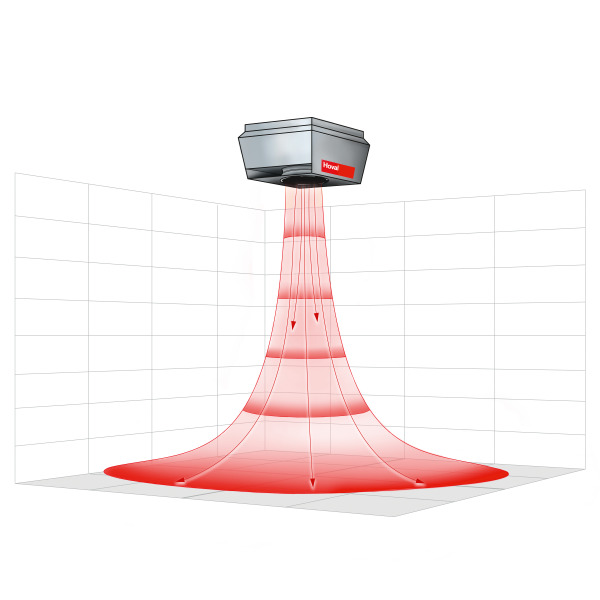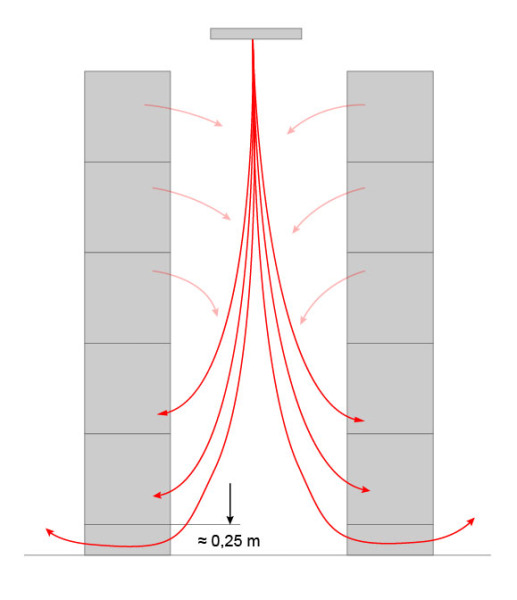Air conditioning systems and ventilation technology: design perfection for logistics halls

Air conditioning systems and ventilation technology: design perfection for logistics halls
When it comes to designing ventilation and air-conditioning systems for logistics halls, the basic principles of flow mechanics always apply – regardless of the specific requirements for the hall temperature.
- Blog
- Product
These principles affect the planning, installation and ultimately the costs (operational and otherwise) of the ventilation technology. To take one example, it is important to aim for a vertical temperature gradient that will minimise heat loss by keeping temperature rises as low as possible, especially in the upper hall area. One way of making this possible is to maintain maximum air circulation down the aisles. The flow conditions will be optimised, for example, by using gridded shelving systems that are permeable and have a generous gap between them and the floor.
Advantages of torsion air distributors
The specific flow properties of torsion air distributors – including the patented Air-Injector from Hoval – ensure that the air inside logistics halls is distributed exactly as required.

In heating mode, a highly concentrated air stream is emitted at high speed from the distributor and a negative pressure difference occurs around the air columner. As a result, the ambient air moves from the ceiling area and, to a lesser extent, from the top shelves towards the air stream. As the depth of penetration increases, the air stream slows down, the surrounding negative pressure decreases and the ambient air is induced. The flow then reaches the bottom shelves.
In order for the flow to pass efficiently to the next shelves, a space of 0.2 to 0.3 metres (m) should be left between the floor and the shelving. The improved air distribution makes it possible to optimise the flow of up to three aisles with a series of air passages. (Refer to Fig. 1: Air flow through aisles.)
Rows of shelves restrict the rotationally symmetrical flow of torsion air distributors. The fronts of the rows of shelves act as walls as far as air flow is concerned, causing wall jets to form. These have a wider reach than open jets and a greater mounting height than is the case with free flow distribution. This increase can be up to 1.5 m.

Fig. 1: Air flow through aisles: the air being supplied vertically from above allows low temperature gradients to be achieved across the whole height. In a hall that is between eight and twenty metres high, the values will typically be between 0.15 and 0.25 Kelvin.
Adhering to set temperatures
If the goods being stored do not have any specific temperature requirements, the ideal room temperature is generally between a frost-free temperature and 16 degrees Celsius. A temperature of around eight degrees Celsius can be considered to be frost-free (when using water-controlled, glycol-free systems and a switching temperature of five degrees Celsius on the frost stat). The individual ventilation units are then operated with the heat output resulting from the maximum possible temperature difference at the fixed mounting height and volumetric current. An on-off control system is all that it takes to maintain a frost-free room temperature and only a few units need to be installed.
Maximum permissible temperatures (upper temperature limit)
These apply, for instance, when storing food or pharmaceutical products and are usually below 25 degrees Celsius. In the case of direct application on the top shelves, the supply air temperature in heating mode may not exceed the upper temperature limit. This allows only a small temperature range and, in turn, a low heat output, meaning a relatively large number of ventilation units need to be installed to maintain the temperature.
This is where torsion air distributors come in, as they boost the temperature range and heat output. In heating mode, the air flow is strongly concentrated and there is no need to supply air directly to the top shelves. Consequently, the supply air can be blown in at a temperature of around three Kelvin (K) higher than the required upper limit temperature. The heat output required can then be achieved with fewer units, which cuts back on the initial investment and ongoing operating costs – and, of course, is good news for the environment too.
During the summer months, the set temperature limits can be maintained using recirculated or outdoor air units. Air from the outside can be used for direct and/or indirect cooling. Automated system control comes highly recommended in order to adhere strictly to these temperature limits.
If a lower and upper temperature limit need to be adhered to, the vertical temperature gradient is crucial. If, for example, goods need to be stored between 18 degrees Celsius and 21 degrees Celsius (3 K), the height of the hall must not exceed 12 m with a gradient of 0.25 K/m.
Centralised vs decentralised supply of media
The supply of heating and cooling media can be centralised or decentralised for recirculated and outdoor air units. As far as logistics halls are concerned, decentralised solutions are the best option. Their implementation with recirculated and/or outdoor air units, equipped with reversible heat pumps, is a lot less costly than a centralised supply consisting of a boiler system, water chiller and the associated hydraulic system. As decentralised systems do not require heating rooms, valuable storage space is also preserved. A further advantage of decentralised heating and ventilation systems is that, from a structural point of view, individual smaller point loads are easier to integrate into a hall structure than large individual loads.
Supply air and pollutant concentration
If diesel forklift trucks are used in a hall, additional country-specific technical regulations are binding. To avoid exceeding permissible pollutant concentrations, the supply air flow must be adjusted accordingly, if necessary.
Modern electric forklift trucks are powered by lithium-ion batteries. No hydrogen is released when they are being charged, which puts them at an advantage over standard lead-acid batteries. This also means that their charging stations do not need to comply with the ATEX Directive for explosion protection and prevention, and no further ventilation measures need to be taken. If shelf conveying systems are in use, the heat released by the systems needs to be taken into account when calculating the cooling load.
 Austria
Austria
 Belgium
Belgium
 Bulgaria
Bulgaria
 Croatia
Croatia
 Czech Republic
Czech Republic
 France
France
 Germany
Germany
 Hungary
Hungary
 Italy
Italy
 Liechtenstein
Liechtenstein
 Luxembourg
Luxembourg
 Poland
Poland
 Romania
Romania
 Russia
Russia
 Slovakia
Slovakia
 Switzerland
Switzerland
 United Kingdom
United Kingdom
 China
China
 Corporate Website
Corporate Website
 Energy recovery
Energy recovery